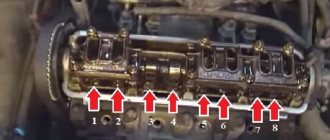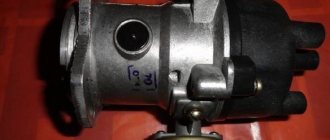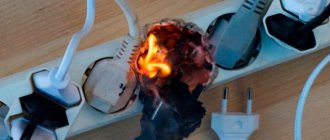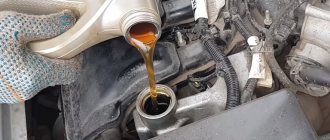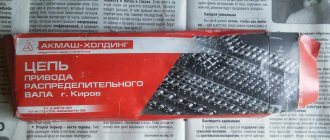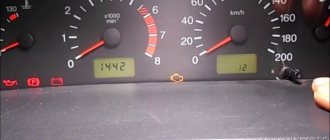If the ignition is adjusted incorrectly, detonation may occur during operation of the power unit. And this, in turn, can lead to a major overhaul of the engine itself.
It’s interesting that in practice, many drivers have their own opinion on how to set the ignition on a VAZ 2106. Some use what is called “by eye,” while others purchase a strobe light for this purpose. Some people don’t try to do it themselves and entrust this work to car service specialists.
To set up the ignition on a VAZ 2106 car with your own hands, use the instructions below.
Preliminary preparation
You need to take with you to the garage:
- candle key;
- key to 13;
- a voltmeter or an ordinary twelve-volt light bulb.
Contact ignition is installed on the first cylinder.
Set the ignition timing using marks of different lengths that are placed on the timing cover.
Main malfunctions of the VAZ 2106 ignition system and their causes
VAZ 2109 ignition system, device, principle of operation
Failures in the VAZ 2106 ignition system occur quite often. They can be caused by a variety of reasons, but their symptoms are almost always the same:
- inability to start the engine;
- unstable operation (triplication) of the engine at idle speed;
- reduction in engine power;
- increased gasoline consumption;
- appearance of detonation.
The reasons for such situations may be:
- failure of spark plugs (mechanical damage, breakdown, exhaustion of service life);
- mismatch of spark plug characteristics (incorrect gaps, incorrect heat rating) with engine requirements;
- wear of the conductor, breakdown of the insulating layer in high-voltage wires;
- burnt contacts and (or) distributor slider;
- formation of carbon deposits on the breaker contacts;
- increasing or decreasing the gap between the breaker contacts;
- breakdown of the distributor capacitor;
- short circuit (break) in the bobbin windings;
- malfunction in the group of contacts of the ignition switch.
What is called ignition timing: main points
The fuel mixture in the cylinder ignites quickly, but not instantly - a certain amount of time passes (about a second) from the moment the spark is formed and the gases expand until the system is activated. During this time, the piston has time to fire, travel the necessary distance and take part in the ignition process. In order to understand what is called the ignition timing angle, it is necessary to understand how the car ignition system as a whole works.
The moment of ignition occurs at the moment when the piston is on the compression stroke and gradually, smoothly approaches TDC. Then the combustion process occurs of a mixture formed from air (not pure oxygen) and gasoline (or diesel fuel, depending on the type of engine used), which form gases characteristic of the reactions taking place. They actively and without stopping push the piston entering the assembly in a downward direction - this moment is called the power stroke.
The energy generated (released) at the moment of direct combustion transforms into another form - mechanical energy that directly starts the crankshaft. The moment of ignition in 95% of cases is determined by its position relative to TDC. In various diagrams or graphs that discuss this process, it is customary to denote the angle in degrees.
Important to remember! If the angle deviates slightly from the normal value towards an increase, then the moment when ignition occurs is called early. Downward changes guarantee later ignition. In these cases, it is necessary to adjust the ignition timing.
All work is divided into several actions that must be performed sequentially. Their order is as follows:
- The engine will need to be turned off (it must cool down if the problem occurs on the road);
- Control is carried out to ensure that the car does not stand in gear (a standing brake is used for this);
- The car key is removed from the ignition;
- You will need to search for marks that should be located next to the timing belt gear;
- The same mark is revealed on another part - the flywheel;
- Then the adjustment of the ignition timing continues - it is necessary to disconnect the wire (it is high-voltage, you should remember this) that approaches the spark plug from the cylinder closest in distance to the radiators (the first one);
- You will need to insert a new spark plug into the wire;
- For convenience, it should be attached to a ground, which may be a hose holder that supplies fuel, located on the valve cover;
- Next you will need to remove the cover from the toggle switch;
- The crankshaft key is placed on the nut located on the flywheel (the operation is performed on the left side of the car);
- The crankshaft will then need to be turned towards you! (if you twist away from you, the flywheel will unscrew);
- While rotating the flywheel, it is necessary to observe the distributor slider, adjusting its position if necessary so that it is in the contact area of the first cylinder.
How to set the ignition timing You should also take into account the values for the marks:
- long – 00;
- average length – 50;
- short – 100.
They vary and depend on the type of engine and make of the car.
After the marks have been set and all the necessary measurements have been made, the key should be removed from the flywheel. The toggle switch cover needs to be returned to its place. At the next stage of work, the car’s ignition can be turned on.
The motor must remain off (not running). Next steps:
- The nut securing the toggle switch is released (it, in turn, turns counterclockwise);
- Then the toggle switch turns, but in a clockwise direction (you will need to perform the action until a spark jumps) It is recommended to repeat the action 2-3 times;
- The toggle switch is fixed in the position where the spark appears;
- The wire (high voltage) is returned and attached to the spark plug of the first cylinder.
The final step is to check the ignition timing setting visually and then during actual movement (driving a car).
Attention! Before the first movement after adjustment, it is necessary to warm up the engine to the recommended (operating) temperature.
How to disassemble the mechanism at home, see the video below (the author of the video is Roman Romanov).
Ignition adjustment of VAZ 2106: preparatory work
If malfunctions occur in the operation of the ignition system, it becomes necessary to adjust it. It is possible to adjust the ignition system either independently or in specialized service centers.
To accurately adjust the ignition, you need a strobe device, which allows you to adjust the car’s ignition in such a way that the internal combustion engine power is maximum, fuel consumption is minimal, and emissions into the atmosphere are within the permissible limits.
How to set the ignition on a VAZ 2106 with your own hands
For independent work on adjusting contact ignition, you will need the following tools and equipment:
- socket wrench set to “13”;
- voltmeter or 12 volt test light;
- spark plug wrench (for installing and removing spark plugs of a car’s internal combustion engine).
Adjustment is carried out on the first or fourth cylinder
Please note that on the VAZ 2106, the ignition is set using marks located on the gas distribution mechanism cover (short - advance angle 10°, medium - advance angle 5°, long - advance angle 0°)
So, in order to understand how to set the ignition on a VAZ 2106 yourself, you need to study the procedure for performing the work. Let's look at how to set the ignition of a VAZ 2106 to the first cylinder:
- Having unscrewed the spark plug of the first cylinder, close the spark plug hole with a rubber plug;
- using a spanner wrench, turn the crankshaft to the compression stroke position in the first cylinder (the rubber plug will be squeezed out);
- continue to turn the crankshaft until its mark coincides with the mark on the timing belt (the middle mark is fuel grade “92” or “95”, the long mark is fuel grade below “72”);
- Unfasten the latches and remove the ignition distributor cover;
when the crankshaft is rotated correctly, the distributor rotor will be rotated to a position in which its outer contact will be directed towards the first cylinder on the distributor cap (when the marks of the cover latches are aligned relative to the internal combustion engine, they should be parallel);
- we connect the wires of the voltmeter or control light to the terminal of the ignition coil connected to the low-voltage wire of the distributor and to ground;
- Having turned on the ignition, you need to slowly turn the distributor clockwise until the lamp goes out or until the voltmeter shows zero;
- rotating the distributor counterclockwise until the lamp lights up, fix it in this position by tightening the fastening nut;
- Turning off the ignition, put the distributor cap back in place;
- using a special strobe device, check whether the ignition is set correctly;
- Also, while driving, you need to make sure that the detonation that occurs disappears as the car accelerates.
Required tools:
- key to "13";
- spark plug key;
- control (a voltmeter or a 12-volt light bulb can be used);
You can set the ignition on the first or fourth cylinder. On our website you can see a description of the ignition installation on the first cylinder.
The short, medium and long mark on the timing cover (gas distribution mechanism) shows the ignition moment of the VAZ 2106.
How to set the ignition of a VAZ 2106 on your own
- Short mark with a leading angle of 10°.
- Average - 5°.
- Long - 0°.
The top dead center is indicated on the pulley rim; opposite TDC there is a special indentation on the pulley hub.
Installing the distributor and adjusting the intercontact gap
When installing a breaker-distributor, it is important to install it so that the OZ is close to ideal
Installation of breaker-distributor
The installation process is identical for contact and non-contact distributors.
Necessary tools and means:
- 38 mm wrench;
- 13 mm wrench;
- control lamp.
The installation procedure is as follows:
- Using a 38 mm wrench, turn the crankshaft by the pulley mounting nut to the right until the mark on the pulley coincides with the middle mark on the timing cover.
- We install the distributor into the cylinder block. We set the slider so that its lateral contact is directed clearly towards the first cylinder.
- We connect all the previously disconnected wires to the distributor, with the exception of the high-voltage ones.
- Connect the hose to the vacuum regulator reservoir.
- Turn on the ignition.
- We connect one probe of the control lamp to the contact bolt of the distributor, and the second to the “ground” of the car.
- We turn the distributor body to the left with our hands until the control lamp lights up.
- We secure the device in this position using a 13 mm wrench and a nut.
Adjusting the breaker contacts
The stability of the power unit, its power characteristics and fuel consumption depend on how accurately the intercontact gap is set.
To adjust the gap you will need:
- 38mm wrench;
- slotted screwdriver;
- flat probe 0.4 mm thick.
Contact adjustments are performed in the following order:
- If the distributor cover and slider are not removed, remove them in accordance with the instructions above.
- Using a 38 mm wrench, turn the engine crankshaft until the cam on the distributor shaft opens the contacts to the maximum distance.
- Using a 0.4 mm feeler gauge, measure the gap size. As already mentioned, it should be 0.35–0.45 mm.
- If the gap does not correspond to the specified parameters, use a slotted screwdriver to slightly loosen the screws securing the contact group stand.
- Use a screwdriver to move the stand towards increasing or decreasing the gap. We take measurements again. If everything is correct, fix the stand by tightening the screws.
- We assemble the breaker-distributor. We connect high-voltage wires to it.
If you are dealing with a contactless distributor, you do not need to make any contact adjustments.
Distributor lubrication
In order for the breaker-distributor to serve as long as possible and not fail at the most inopportune moment, it must be looked after. It is recommended to visually inspect it at least once a quarter, remove dirt from the device, and lubricate it.
At the beginning of the article, we said that there is a special oiler in the distributor housing. It is needed to lubricate the shaft support sleeve. Without lubrication, it will quickly fail and contribute to shaft wear.
Clean engine oil is used for lubrication
To lubricate the bushing, you need to remove the distributor cover, turn the oil can so that its hole opens, and drop 5-6 drops of clean motor oil inside it. This can be done using a special plastic oil can or a medical syringe without a needle.
Video: distributor lubrication
Systematically maintain the distributor of your “penny”, repair it on time, and it will serve for a very long time.
Installing an electronic BSZ instead of a contact one
Today it is very rare to find a “seven” with contact ignition. With the arrival on sale of switches, distributors and coils for electronic spark generation systems, owners of classics began to massively re-equip their cars.
What is included in the BSZ kit
The process of converting a contact system into an electronic one is quite simple, and also inexpensive. The cost of an electronic ignition kit for a VAZ 2107 is about 2,500 rubles. It includes:
- transistor switch type 3620.3734 with connector;
- coil 27.3705;
- contactless distributor type 38.3706;
- connecting wires.
In addition, you will need spark plugs (preferably new ones) with a gap of 0.7–0.8 mm and a set of high voltage wires. Coil type B-117A (used in a contactless system) is not suitable for electronic ignition. Its characteristics do not correspond to those of other equipment in the circuit.
Video: review of BSZ elements for “classics”
Required Tools
To complete the work you will need:
- 8, 10 and 13 mm wrenches;
- screwdriver with a Phillips blade;
- drill;
- spark plug key;
- 36 mm wrench or with a ratchet mechanism for turning the crankshaft;
- self-tapping screws;
- pliers.
Work order
Work on converting the ignition system into a contactless one is carried out in the following order:
- Disconnect the terminals from the battery. We remove the battery and put it aside.
- Remove the high voltage caps from the distributor cap and from the spark plugs.
- Using a special wrench, unscrew all the spark plugs. We screw new ones in their place.
- Using a drill, drill holes on the left mudguard or on the engine shield to mount the switch.
- We attach the switch to the car body using self-tapping screws.
- Remove the distributor cap.
- We rotate the crankshaft, placing a wrench on the nut securing its pulley, until the distributor runner is aimed at the spark plug of the first cylinder, and the mark on the pulley points to the middle ebb on the timing cover.
- Using a 13 mm wrench, loosen the distributor mounting nut.
- Remove the vacuum hose from the distributor and disconnect all wires.
- We remove the old distributor from its seat.
- Remove the cover from the new distributor.
- Trying it on in place of the old one, we rotate the slider by hand until it is directed towards the first cylinder.
- We install a new distributor, tighten the nut, but do not tighten it completely.
- We connect the wire connectors and the vacuum regulator hose to the new distributor.
- We dismantle the old ignition coil by unscrewing the nuts securing it with a 13 mm wrench. We disconnect all wires from it.
- We install the new coil in place.
- We connect the connector with the wiring harness to the switch.
- We clean the ends of the wires. We install the chain:
- We securely attach the black wire from the switch to ground using a self-tapping screw or screw;
- connect the red wire to terminal “K” on the coil. We also attach the brown wire from the tachometer here;
- connect the blue wire from the switch and the blue wire with a black stripe to the “+B” terminal on the coil.
- We install the distributor cover and secure it. We connect new high-voltage wires to the cover and spark plugs.
- Let's try to start the engine. If it works, then everything was done correctly. Otherwise, we check the ignition circuit and the reliability of the connection of its elements.
Switch
The last element in the circuit, the presence of which is required by a contactless electronic ignition system, is a switch. The ideal place in which it can be installed in a VAZ 2107 is between the washer reservoir and the left headlight. There is a flat area on which we will install the switch, with the radiator facing the body. Having leaned the switch, we mark the places for drilling holes in the body, through which we fasten it with self-tapping screws; in this case, you need to screw the black (neutral) wire from the connection block under one of the screws.
After completing all the work described above, you should once again carefully check the connection of the wires according to the circuit diagram. If everything is done correctly, you can try to start the engine. Usually there are no problems with this; all that remains is to adjust the ignition to ensure the most efficient operation of the engine.
Self-adjustment without strobe
Problems with ignition in VAZ 2106 cars can also arise due to the marks of the engine gas distribution system being knocked down during repairs. We invite you to watch a video of installing the ignition and performing related settings for the VAZ 2106:
Preparatory stage
To set the ignition on a VAZ 2107 car, no special conditions are required; the operation can be done both in the garage and on the street, including in winter. For work, prepare the following set of tools:
- flat screwdriver;
- metal probe 0.35 mm thick;
- open-end wrench size 13 mm;
- a car light bulb designed for a voltage of 12 V with wires soldered to it;
- a wrench with a long handle designed to turn the crankshaft;
- key for unscrewing spark plugs.
Ignition tuning tool
Ideally, it is better to have in your arsenal a device for setting the ignition on a running engine - a strobe light. It is equipped with a lamp that flashes simultaneously with the moment of spark formation in the cylinder, which allows you to see the position of the notch on the crankshaft pulley at idle speed and clearly adjust the advance angle.
This is what a strobe looks like, which is convenient for adjusting ignition timing
Important point. The ignition is set in order to ensure that the spark appears in a timely manner and the engine starts, after which additional adjustments will be required. But the latter will not bring you the desired result when there is no compression in the cylinders or problems with the carburetor make themselves felt. If these faults are not eliminated, the engine operation will remain unstable, no matter how you configure the spark generation system.
Device malfunctions
Replacement and repair of the distributor on the domestic “six” is carried out in the event of incorrect operation of the mechanism.
We recommend: Instrument panel on Hyundai cars and its features
Below are the main symptoms of breakdowns that indicate possible malfunctions:
- The vehicle jerks while driving. Moreover, these jerks are completely uncharacteristic of a car.
- The engine generally does not start.
- When trying to accelerate the car, the car may also jerk, and the acceleration process itself takes a lot of time, and the engine may detonate - the piston rings knock.
- Increased fuel consumption.
As you can see, in general the symptoms are similar to those that appear when the ignition is set incorrectly. Of course, if such symptoms appear, it cannot be said for sure that the fault lies in the distributor, but attention should also be paid to diagnosing this unit.
As for the breakdowns that may force the car owner to repair or replace the mechanism, they are as follows:
- The unit slider is worn out and burnt out.
- The problem lies in the cover itself - the contacts on it could have burned out.
- Hall sensor failure. The problem may be associated not only with a breakdown of the controller, but also with poor contact on the regulator plug.
- Another reason that domestic drivers encounter quite often is the distributor bearing. After a long period of use, it could become loose, but it could also simply jam.
- Presence of mechanical damage, including cracks on the cover.
- Engine fluid gets into the distribution unit; usually the problem is related to the seal of the cap.
How to install contactless (electronic) ignition
Installing electronic ignition is the easiest way to improve engine performance. Replacing with a contactless system provides the following advantages:
- Confident cold start;
- Stable engine operation at any speed;
- High reliability;
- Increases the service life of spark plugs;
- Powerful spark;
- No gap adjustment or centrifugal adjuster required.
The finished kit includes a distributor with a Hall sensor, a special ignition coil and a switch. It is possible to leave the old high-voltage wires.
The electronic ignition system includes: an ignition coil, a distributor, a switch and a set of wires
To install contactless ignition to replace the old one, we need a key for “13” and “10”, two screws for fastening the switch and a strobe for adjusting the advance angle.
The order of work performed:
- We bring the crankshaft pulley to the mark on the engine cover, the piston of the first cylinder should be at TDC.
- Disconnect the negative terminal of the battery.
- Remove the cover from the old distributor and note the position of the slider relative to the engine. This will help you quickly install and configure the new distributor.
- We disconnect the wire coming from the ignition coil, unscrew the lock with a key set to “13” and remove the distributor from the engine block.
- We install the new distributor according to the marks made, trying to align the marks on the body and the position of the slider. Do not tighten the fastening completely.
- We replace the ignition coil with a new one and install the switch under the hood. Place the electronic unit in a dry place, away from heated parts. For example, on the wing or engine shield.
- We connect the wiring according to the diagram in the instructions for the BSZ. We connect high-voltage wires.
- Close the distributor with the lid and tighten the fastening nut. The system is installed and ready to use. All that remains is to adjust the ignition timing.
Purpose and types of distributors
The main distributor of the “six” is located on a horizontal platform made to the left of the engine valve cover. The unit shaft, ending with splines, enters the drive gear inside the cylinder block. The latter rotates by the timing chain and at the same time rotates the oil pump shaft.
There is a special platform for installing the distributor on the engine block.
The distributor performs 3 functions in the ignition system:
- at the right moment it breaks the electrical circuit of the primary winding of the coil, causing a high voltage pulse to form in the secondary;
- alternately directs discharges to the spark plugs according to the operating order of the cylinders (1-3-4-2);
- automatically adjusts the ignition timing when the crankshaft speed changes.
The distributor distributes impulses among the spark plugs and ensures timely sparking
The spark is supplied and the air-fuel mixture is ignited before the piston reaches the upper extreme point, so that the fuel has time to fully burn. At idle, the advance angle is 3-5 degrees; with increasing crankshaft speed, this figure should increase.
Various modifications of the “sixes” were equipped with different types of distributors:
- VAZ 2106 and 21061 were equipped with engines with a working volume of 1.6 and 1.5 liters, respectively. Due to the height of the block, distributors with a long shaft and a mechanical contact system were installed on the model.
- VAZ 21063 cars were equipped with a 1.3 liter engine with a low cylinder block. The distributor is a contact type with a shortened shaft, the difference for models 2106 and 21063 is 7 mm.
- The updated VAZ 21065 series was equipped with contactless distributors with a long rod, working in conjunction with an electronic ignition system.
The difference in the length of the shafts of 7 mm is due to the different volumes of the motors used on the “six”
The difference in the length of the drive shaft, depending on the height of the cylinder block, does not allow the use of the VAZ 2106 part on a 1.3 liter engine - the distributor simply will not fit into the socket. Installing a spare part with a short shaft on a “clean six” will also not work - the splined part will not reach the gear. The rest of the filling of the contact distributors is the same.
As a young, inexperienced driver, I personally encountered the problem of different lengths of ignition distributor rods. On my Zhiguli VAZ 21063, the distributor shaft broke off on the road. At the nearest auto store I bought a spare part for the “six” and began installing it on the car. Result: the distributor was not inserted completely; a large gap remained between the platform and the flange. Later the seller explained my mistake and kindly replaced the part with one suitable for the 1.3 liter engine.
Contactless distributor
The device of the distributor, functioning with the electronic ignition mechanism, is similar to the design of a mechanical distributor. This device also has a slider, a plate with a bearing, a vacuum corrector and a centrifugal regulator. However, the contact group and capacitor are replaced by a Hall sensor and a metal screen fixed on the shaft.
The contactless distributor in the 2106th model works as follows:
- A permanent magnet and Hall sensor are located on the moving section. A screen with slits rotates between them.
- As soon as the magnet field is blocked by the screen, the voltage is zero at the terminals and the sensor is inactive.
- When the roller rotates and overcomes the slot, the magnet field reaches the sensor surface. In turn, a voltage is generated at the output of the element, which is sent to the electronic unit (switch). The latter sends a signal to the coil, which generates a discharge going to the ignition slider.
The non-contact dispenser is more durable in operation. The bearing and Hall sensor fail less often due to the lack of mechanical stress.
Features of UOZ
The ignition timing angle, or as it is usually designated, the ignition timing, has a number of features that must be taken into account for the stable operation of all components in the engine. The following features are noted:
- In engines that are injected, the OZ is installed independently, since the system has a similar function. The angle at the moment the motor is running is determined. The system is based on the readings of a three-dimensional function and engine load. The operating mode of the engine (winter-summer) and the speed at which the crankshaft rotates is also important. If all indicators correspond to the optimal parameters, the control system independently selects and sets the ignition timing;
- The optimal SOP for a particular engine, in turn, is determined by the speed at which the crankshaft operates. A special feature is the fact that a higher number of revolutions ensures a reduction in the time required for ignition;
- Temperature indicators also affect SOP. Low slows down oxidation processes, as a result of which the likelihood of an early ignition timing increases; high determines late ignition timing.
- The loads that the engine experiences are large and guarantee that there will be a high level of cyclic filling of the cylinder. In this case, it will be necessary to reduce the ignition timing. If this is not done, an explosion may occur in the engine, that is, detonation.
Stages of work using a strobe light
For installation of ignition using a strobe light on a VAZ 2106, at official dealership centers you will need to pay from 1000 to 1500 rubles. If you want to save this amount, you can carry out all the work yourself, for which you need to complete the following steps:
- We park the car indoors, give the engine time to cool to avoid accidental burns to your hands, and then slightly unscrew the distributor lock nut.
On the engine crankcase cover we find three marks, having previously cleaned it of operational contaminants, then we connect the strobe with wires to ground (black), to the ignition coil (red) and the high-voltage wire of the first cylinder (special clamp) and start the car.
- We direct the beam of a working strobe light to the crankshaft pulley, look at the relationship of its mark with the marks on the front cover of the engine, and slowly rotate the distributor around its axis until the required ignition timing angle is set, and after achieving the required result, tighten its lock nut.
You can set the correct ignition without using a strobe, which will require the use of a 12-volt test lamp.
Ignition installation steps
To understand how to set the ignition of the VAZ-2109, (2105, 2106), just read the instructions described below. The design of these models is almost identical. To implement this task, it is necessary to study the design features of the system. The adjustment is carried out in three stages:
1. First you need to unscrew the spark plug above the first cylinder. The empty connector must be closed with a plug or finger; in the process, start turning the crankshaft with a wrench until you find the compression stroke. 2. The ignition crankshaft pulley has a special line, which should be located at the same level as the mark located on the front cover. 3. The distributor should be installed in such a position that the slider is placed parallel to the cover to which the high-voltage cable connector is connected.
Let's look in detail at how to set the ignition of a VAZ 2106 (2105, 2109) and what is needed for this. First you should prepare the following tools: a 13mm wrench, a voltmeter or a light bulb for control. The gas distributor cap has three special marks. They are used to adjust the ignition timing. The labels correspond to the following values:
- short position for an angle of 10 degrees;
middle position - 5;
long label - 0.
Typically, the pulley rim also has a TDC mark. Opposite it, a tide is placed on the hub. The ignition timing value is adjusted only for cylinders 1 and 4. Sequence of stages:
Remove the spark plug from cylinder 1 and plug the hole with a finger or plug. Using a wrench, turn the crankshaft until pressure builds up in cylinder 1 to push out the plug. Then continue turning the crankshaft until one of the marks aligns with the mark on the timing cover.
If the car is operated on 92 (95) grade gasoline, align the mark with the middle mark; if you use fuel with an octane rating of less than 92, place the mark opposite the long strip. Disconnect the distributor. After performing the above operations, the distributor rotor should be in a position in which the outer contact is directed towards the 1st cylinder.
By aligning the marks, you should get an imaginary line running parallel to the motor axis. If you cannot achieve this result, you must proceed with the following operations. First, unscrew the distributor fastening nut using the appropriate wrench, lift the distributor to the top and turn the mechanism to the desired position by turning the rotor axis. Place the part in place, fix it, but do not fully tighten the fastening segments. Next, we will look at the immediate steps of how to set the ignition.
- Prepare a test light (voltmeter). Connect one wire to the output of the coil, to which the low-voltage cable of the distributor should be connected. And connect the other wire to body ground.
Turn on the ignition. At this moment the warning lamp should light up. Next you need to make it go out. If the lamp does not light, skip the next step.
Turn the distributor clockwise until the lamp stops burning (no voltage).
Slowly turn the distributor counterclockwise until the control lamp lights up (voltage appears). After this, fix the location of the part and tighten the fastening segments.
Turn on the ignition and place the distributor cap in its original place.
Setting the advance angle
After carrying out repair work or replacing the ignition distributor on a “penny”, it is necessary to set the correct ignition timing
Since this can be done using different methods, we will consider the most common of them, but it is important to know in what order the cylinders operate: 1–3–4–2, starting from the crankshaft pulley
By light bulb
This method is suitable if there are no special devices at hand. You only need a 12 V lamp, for example, from turn signals or markers with two wires soldered to it with stripped ends and a key for 38 and 13. The adjustment is performed as follows:
- We unscrew the spark plug element of the first cylinder.
- We turn the crankshaft with a 38mm wrench until the compression stroke begins in the first cylinder. To determine this, you can cover the hole for the spark plug with your finger, and when force occurs, compression will begin.
- We install the marks on the crankshaft pulley and the timing cover opposite each other. If the car is operated on 92 gasoline, then you should choose the middle mark.
- Remove the ignition distributor cover. The slider should point towards the first cylinder on the cover.
- Loosen the nut holding the mechanism.
- We connect the wires from the light bulb to ground and the distributor contact.
- Turn on the ignition.
- We turn the distributor until the lamp lights up.
- We clamp the distributor mount, put the cover and spark plug in place.
Regardless of the method of installing the ignition, at the end of the process I check the operation of the engine in motion. To do this, I accelerate the car to 40 km/h and sharply press the gas, while the engine must be warmed up. With the ignition set correctly, detonation should appear and literally disappear immediately. If the ignition is early, the detonation will not disappear, so the distributor needs to be turned slightly to the left (to be done later). If there is no detonation, the distributor should be turned to the right (done earlier). Thus, it is possible to precisely adjust the ignition according to the behavior of the engine, depending on the fuel used and its quality.
Video: setting the ignition on a VAZ using a light bulb
By strobe
Using a stroboscope, the ignition can be set accurately, without the need to remove the cover on the distributor itself. If you purchased or borrowed this device, then set up in the following order:
- Loosen the distributor fastening.
- We connect the minus of the strobe to ground, the positive wire to the low-voltage part of the ignition coil, and the clamp to the explosive cable of the first cylinder.
- We start the engine and turn on the device, pointing it at the crankshaft pulley, and a mark corresponding to the ignition moment will be displayed.
- We rotate the body of the adjustable device, ensuring that the marks on the crankshaft pulley and the front cover of the engine match.
- Engine speed should be around 800–900 rpm. If necessary, we adjust them with the corresponding screws on the carburetor, but since the VAZ 2101 does not have a tachometer, we set the minimum stable speed.
- We clamp the distributor mount.
Video: setting up the ignition using a strobe light
Aurally
If there is a need to adjust the ignition, but there is no light bulb or special device at hand, the adjustment can be done by ear. The work is carried out on a warm engine in the following sequence:
- Slightly unscrew the distributor mount and slowly rotate it to the right or left.
- At large angles the engine will stall, at small angles it will gain speed.
- During rotation, we achieve stable speeds within 800 rpm.
- We attach the distributor.
Video: adjusting the ignition on a “classic” by ear
Despite the apparent complexity of the ignition system, you can determine the problem, as well as adjust the formation and distribution of the spark at the right moment, with your own hands. To do this, you need to read the step-by-step instructions and follow them in the process of finding problems, eliminating them, and also carrying out adjustment work.
Read with this
- Correct ignition adjustment on a VAZ 2107 carburetor
- Ignition distributor
- Purpose of a spark on a VAZ 2106, reasons for its absence and troubleshooting
- How to set up the ignition on a carburetor VAZ 2107
- Types, design and principle of operation of the ignition system
- Contactless ignition VAZ 2106: device, operation diagram, installation and configuration instructions
- Hall sensor VAZ 2108 and 2107: how to check, replacing the regulator and video
- Ways to independently check the ignition module
- Checking the ignition timing
- Silent blocks of front levers of VAZ 2107 which are better
Signs of a faulty ignition coil, symptoms of problems
The main signs of a faulty ignition coil are:
- The vehicle will not start.
- Reduced motor performance.
- Dips at certain speeds.
- Misfires.
- Coil overheating.
- The Check Engine light is flashing.
It is worth noting that the following factors can contribute to coil failure:
- Insulation damage due to high voltage. This phenomenon can be observed when the voltage is exceeded.
- Overload that occurs when the spark plug or high-voltage wire is faulty.
- Strong vibration and heating, which results in a violation of the insulation of the device. The ignition coil is distinguished by the presence of several layers of insulation. If they are damaged, an insulation breakdown occurs, which leads to a short circuit or even a circuit break.
ADJUSTMENT SET IGNITION
The ignition installation on the VAZ 2105 significantly affects the stability of the engine. If it is set incorrectly, various problems arise. If it is early, the following unpleasant moments may occur:
- Detonation appears in the engine, and when accelerating, your fingers “knock” a lot;
- Problems when starting the internal combustion engine - the starter turns with difficulty, there is a kickback;
- The engine shakes when the speed increases;
- Idle speed floats.
Late ignition also has many signs of unstable engine operation, causing quite a lot of trouble for car owners:
- Loss of internal combustion engine power;
- Popping sounds in the carburetor or muffler;
- Dips when pressing the gas pedal;
- Increased engine heating;
- Long engine start.
How to set the ignition on a VAZ 2105 is of interest to many novice car enthusiasts. The adjustment process is not difficult at all, and it is quite easy to do it yourself. What tools are required depends on the methods by which the adjustment will be made.
How to adjust the ignition on a VAZ 2105? There are several ways to set the ignition on a VAZ 2105:
- Using a strobe light;
- I use a 12-volt automotive light bulb;
- Experimentally with the engine running;
- Just by the marks.
Tags When making adjustments on their own, few car owners use a strobe light. At a minimum, it costs 600 rubles, and adjusting the ignition of the VAZ 2105 is so simple that purchasing the device is not justified. The cost of work at a car service center to install the ignition is around 100 rubles. Therefore, sometimes it makes sense to entrust the work to specialists - they have sufficient experience and will do everything quickly and efficiently.
LOOK BY BULB
To set the ignition on a VAZ 2105 using a light bulb, you will need tools and accessories:
- A 12 Volt light bulb screwed into a socket from which two wires come;
- Open-end or combination wrench 13;
- Key for turning the ratchet by 38.
We carry out the work with the engine turned off in the following order:
- We remove the distributor cover, do not pull out the high-voltage wires;
- To set the ignition on a VAZ 2105 according to the marks, turn the crankshaft with a ratchet wrench until the mark on the c/shaft pulley aligns with the middle mark on the front cover of the internal combustion engine. There are only three marks on the cover, and the middle one will indicate an advance of 5 degrees. You also need to take into account that when combining the marks, either the first or fourth cylinder can be set. The cylinder is checked by the slider - the slider should point towards the first cylinder (if you look at the distributor cover);
- We loosen the distributor body with a 13mm wrench - now it can move freely along the axis;
- We connect one end of the wire from the light bulb to ground, the other end to the low voltage circuit in the distributor circuit (possibly with contact “K” on the coil);
- Turn on the ignition by turning the key in the lock and begin to turn the distributor in both directions. As it rotates, the light will turn on and off. You need to find the position in which the lamp starts to light up. It is in this position that you need to secure the distributor with a 13 key;
- The adjustment is completed - turn off the ignition, put the distributor cap in place, remove the light bulb and start the engine to check. When you press the gas pedal very sharply, you should barely hear “fingers” - this will be a sign of the correct setting.
EXPERIMENTALLY BY HEARING
You can use the “old-fashioned” method and make adjustments by ear:
- We start the engine;
- Loosen the nut securing its body by 13, while holding the distributor from turning;
- We try to turn it in one direction or another;
- We find the moment when the engine reaches maximum idle speed;
- Move the body slightly clockwise;
- We fasten the nut to 13 and check the operation of the engine while running. If the adjustment is not satisfactory, we do it again.
Checking the adjustment results
Let's move on to the last stage, we need to check the results obtained. The results are checked based on the car's behavior on the road. You need to warm up the engine, drive out onto a flat section of the road, pick up a speed of 40-50 km/h, engage fourth gear and sharply press the gas pedal . Within 1-2 seconds, characteristic knocking sounds similar to clattering will be heard, and the car will immediately begin to confidently pick up speed.
If no sounds are heard, then you need to turn the distributor counterclockwise one notch, this procedure must be repeated until a sound is heard.
The cause of the malfunction may also be a deviation of the fuel composition from the nominal one, as well as incorrect operation of the distributor systems.
“>



